Why do some women have 'four-color vision' that distinguishes 100 times as many colors as ordinary people?

by
Generally, people identify one million colors, but it is thought that there are people in the world who have 'four-color type color vision ' that identifies 100 million colors, which is 100 times that number. According to one theory, 12% of women have 4-color vision, but why only women have 4-color vision and why 4-color vision appears? The neurosphere explains.
The mystery of tetrachromacy: If 12% of women have four cone types in their eyes, why do so few of them actually see more colors? – The neurosphere
https://theneurospherecom.wordpress.com/2015/12/17/the-mystery-of-tetrachromacy-if-12-of-women-have-four-cone-types-in-their-eyes-why-do- so-few-of-them-actually-see-more-colours /
Humans have three cone cells in their eyes: red cones (L cones), green cones (M cones), and blue cones (S cones), each of which feels color and the brain. I get 'color vision' by sending the message 'What color is this!' Generally, one pyramidal cell identifies about 100 different colors, and by combining three of them, a person identifies a total of 1 million colors.
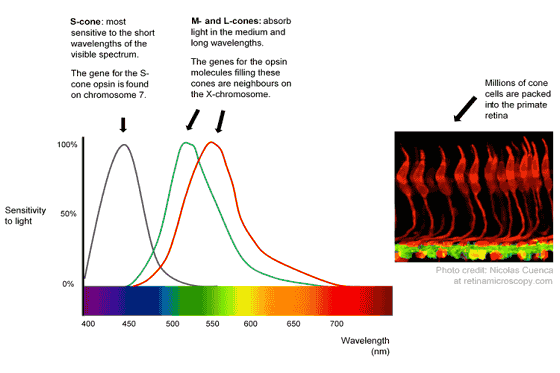
However, as research progressed, 'the possibility that some people have four pyramidal cells' emerged. Having four pyramidal cells means that you can perceive more than 100 million colors. According to one theory, women with this 'supervision' account for 12% of all women.

So why are only women with supervision?
◆ Is the 'fourth pyramidal cell' a fact?

by
The three pyramidal cells sense color and send signals to the brain, which is possible because a molecule called opsin contained in the pyramidal cells absorbs the wavelength of light. The molecule of opsin is different for each pyramidal cell, and it is sensitive to the wavelength of the visible spectrum, which is its specialty. In other words, a person who has a fourth pyramidal cell can be rephrased as 'a person who has an opsin that can recognize a different wavelength of light', which is different from the currently known opsin.
Generally, it is said that the wavelength of light that humans can recognize is from 400 to 700 nm. Since snakes and bees can capture wavelengths of light that humans cannot recognize, in science fiction movies, etc., you may gain special abilities by multiplying humans with snakes, but in reality there are women with supervision. For example, it is mainly due to changes in DNA sequences and heredity.
When a gene related to opsin is mutated, which actually changes the way opsin molecules receive light, a 'fourth pyramidal cell' occurs. At this time, the genes for opsin in the M and L cones are located on the X chromosome, so mutations in genes related to supervision occur only in females. If a man inherits the mutated opsin gene from his mother, he will have a trichromacy because he has only one X chromosome. By inheriting the normal S cone contained in chromosome 7, the normal L cone contained in the X chromosome, and the mutant M cone, 'the number of colors that can be recognized is the same, but the colors that can be seen are the same as those of humans. Because you will be a 'different' type of color blind person.
However, females have two X chromosomes. Therefore, in addition to the normal M and L cones contained on the X chromosome, there is a possibility of having mutated M and L cones. This is the reason why only women 'may have supervision'.
◆ How to distinguish 4-color type color vision
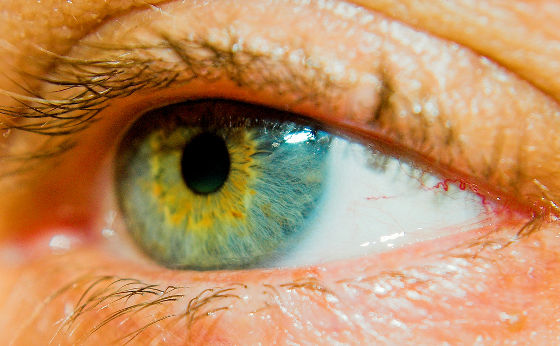
by Serge
It is not easy to distinguish a female with four-color vision from all women, so researchers first recruited a female with a son with color blindness. As mentioned above, male mothers with color blindness may have mutations in the M and L cone opsin. He asked the women if they could see the difference by showing a change in color that was indistinguishable to the general public.
People with color blindness have the property that 'a specific color that many people can identify looks the same', but when I tested the mothers of color blind people, they actually had a lot of them. He said he was able to recognize the difference in color that people could not recognize.
Researchers then perceive that the fourth pyramidal cell is 'the same color as the son sees' because the mother and son have the same 'specially mutated pyramidal cells.' I made a hypothesis.
What can be derived from this hypothesis is whether to have supervision by asking a woman 'a difference in color that her son with color blindness can tell the difference, but no one else can see the difference'. I wonder if you can tell. Therefore, researchers devise some tests based on past discoveries.
In 1992, using human DNA, S-cone, L-cone, and M-cone opsin were generated in cells, and the reaction to the wavelength of light was observed. This experiment showed how easy it is to calculate the signal when each pyramidal cell is stimulated by the wavelength of light.
For example, the graph below shows the reaction of the M cone. The sunspot on the far left is the reaction of M-pyramidal cells to light at a wavelength of 490 nm, suggesting that it is not very sensitive to this wavelength. The sunspot in the middle is when it receives a wavelength of 530 nm light, at which time the M cone sends the most signal. The sunspot on the far right shows the reaction when it receives a wavelength of light of 600 nm and produces almost no signal.

Based on the results of this study, the researchers mixed the wavelengths of light that the general public felt the same, but those with color blindness could see the difference, and observed the reactions of the subjects.
First of all, the following is the reaction of people with normal trichromatism. The M and L cones are reacting to light with a wavelength of 590 nm.
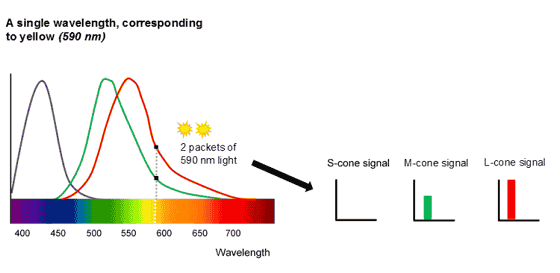
And this is the reaction when the wavelengths of light of 540nm and 670nm are mixed. If you mix the two wavelengths, you can see that the brain recognizes it as the same as the wavelength of 590 nm.

Next, we are looking at the reaction of a person who has a mutation in the M cone and sends a signal to the L cone compared to normal. First, the reaction to the wavelength of 590 nm.
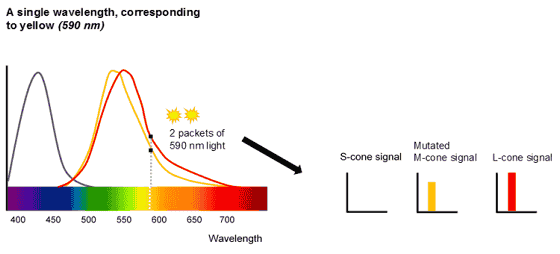
And this is the reaction to the mix of wavelengths of 540nm and 670nm. If you compare the graph on the right with the one above, you can see that the light is recognized as a different thing as a result of the calculation.

That is, people with mutation-type trichromatism distinguish between two wavelengths that are normally perceived as 'same,' and therefore colors look different from most people. That there is. The hypothesis is that the mother of a man with this color vision deficiency has a mutant M-cone and a normal M-cone, and can distinguish more colors.
However, in reality, people with 4-color vision do not always react differently to color than people with 3-color vision. In experiments, mothers of sons without color blindness and mothers of sons with color blindness often responded similarly. Genetic analysis revealed that at least 7 out of 9 mothers of their sons with color blindness had 4-color vision, but this mother's color vision was superior to that of 3-color vision. It remains a mystery that it is not.
However, one of the above seven mothers said that he could distinguish colors that only his son could distinguish. So what's the difference between a four-color-blind mother who can distinguish colors that are indistinguishable from others and a four-color-blind mother who can't tell?
◆ Elements other than '4 color type color vision'
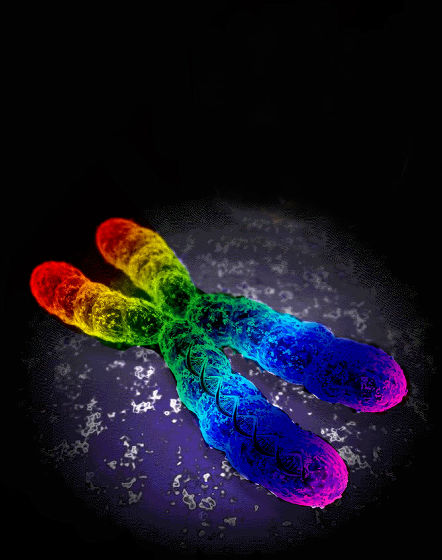
by
In this regard, there is a view that there are two types of gene mutations, one that is not so important and the other that is important. Some opsin genes also cause major changes in proteins, while others do not.
Below is a graph comparing the reactions of the fourth cone of two females with four-color vision. The response of the fourth cone of the female on the left almost overlaps with that of the L cone, and it is possible that the brain perceives the two signals as identical. On the other hand, the fourth cone of the female on the right is between the M and L cones and does not overlap with any of the graphs. In other words, the fourth cone sends a different signal than the S, L, and M cones, so it was possible to distinguish more colors than a normal person.
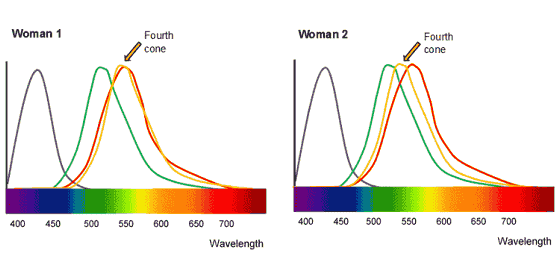
Related Posts:
in Science, Posted by darkhorse_log






